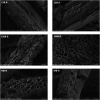Detoxification of corn stover prehydrolysate by different biochars and its effect on lactic acid fermentation
- PMID: 38304560
- PMCID: PMC10828635
- DOI: 10.1039/d3ra08055b
Detoxification of corn stover prehydrolysate by different biochars and its effect on lactic acid fermentation
Abstract
During the utilization of lignocellulosic biomass such as corn stover, many by-products are produced in the pretreatment process that can severely inhibit the activity of microbes in the fermentation step. To achieve efficient biomass conversion, detoxification is usually required before microbial fermentation. In this study, the prehydrolysate from dilute acid pretreatment of corn stover was used as a lactic acid fermentation substrate. Biochars made from corn stover (CSB), cow manure (CMB), and a mixture of corn stover and cow manure (MB) were applied for the detoxification of the prehydrolysate. All three types of biochar had a porous structure with a specific surface area ranging from 4.08 m2 g-1 (CMB) to 7.03 m2 g-1 (MB). After detoxification, both the numbers of inhibitors and their concentrations in the prehydrolysate decreased, indicating that the biochars prepared in this study were effective in inhibitor removal. The concentration of lactic acid obtained from the prehydrolysate without detoxification was only 12.43 g L-1 after fermentation for 96 h with a productivity of 0.13 g (L h)-1. Although the specific area of CMB was the lowest among the three biochars, the CMB-treated prehydrolysate resulted in the highest lactic acid concentration of 39.25 g L-1 at 96 h with a productivity of 0.41 g (L h)-1. The lactic acid bacteria in the CMB-treated prehydrolysate grew faster than the other two biochars, reaching an OD value of 8.12 at 48 h. The results showed promise for the use of agricultural wastes to make biochar to increase the yield of lactic acid fermentation through the detoxification process.
This journal is © The Royal Society of Chemistry.
Conflict of interest statement
There are no conflicts to declare.
Figures






References
-
- Malinowski A. Wardzińska D. Chemik. 2012;66(9):982–990.
-
- Ma X. Gao M. Liu S. Li Y. Sun X. Wang Q. Bioresour. Technol. 2022;352:127108. - PubMed
-
- Nathan M. Charles W. Bruce D. Richard E. Lee Y. Y. Mark H. Michael L. Bioresour. Technol. 2005;96:673–686. - PubMed
-
- Brienzo M. Abud Y. Ferreira S. Corrales R. C. N. R. Ferreira-Leitao V. S. de Souza W. Sant'Anna C. Ind. Crops Prod. 2016;84:305–313.
LinkOut - more resources
Full Text Sources
Miscellaneous

